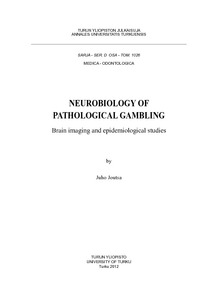Neurobiology of pathological gambling. Brain imaging and epidemiological studies
Joutsa, Juho (2012-08-31)
Neurobiology of pathological gambling. Brain imaging and epidemiological studies
Joutsa, Juho
(31.08.2012)
Annales Universitatis Turkuensis D 1026 Turun yliopisto
Julkaisun pysyvä osoite on:
https://urn.fi/URN:ISBN:978-951-29-5092-8
https://urn.fi/URN:ISBN:978-951-29-5092-8
Kuvaus
Siirretty Doriasta
ei tietoa saavutettavuudesta
ei tietoa saavutettavuudesta
Tiivistelmä
Pathological gambling, a form of behavioral addiction, refers to maladaptive, compulsive
gambling behavior severely interfering with an individual’s normal life. The prevalence
of pathological gambling has been estimated to be 1–2% in western societies. The reward
deficiency hypothesis of addiction assumes that individuals that have, or are prone, to
addictions have blunted mesolimbic dopamine reward signaling, which leads to compulsive
reward seeking in an attempt to compensate for the malfunctioning brain reward network.
In this research project, the effects of gambling were measured using brain [11C]
raclopride PET during slot machine gambling and possible brain structural changes
associated with pathological gambling using MRI. The subjects included pathological
gamblers and healthy volunteers. In addition, impulse control disorders associated with
Parkinson’s disease were investigated by using brain [18F]fluorodopa PET and conducting
an epidemiological survey.
The results demonstrate mesolimbic dopamine release during gambling in both
pathological gamblers and healthy volunteers. Striatal dopamine was released
irrespective of the gambling outcome, whether the subjects won or not. There was
no difference in gambling induced dopamine release between pathological gamblers
and control subjects, although the magnitude of the dopamine release correlated with
gambling related symptom severity in pathological gamblers. The results also show that
pathological gambling is associated with extensive abnormality of brain white matter
integrity, as measured with diffusion tensor imaging, similar to substance-addictions.
In Parkinson’s disease patients with impulse control disorders, enhanced brain [18F]
fluorodopa uptake in the medial orbitofrontal cortex was observed, indicating increased
presynaptic monoamine function in this region, which is known to influence signaling in
the mesolimbic system and reward processing. Finally, a large epidemiological survey
in Finnish Parkinson’s disease patients showed that compulsive behaviors are very
common in Parkinson disease and they are strongly associated with depression.
These findings demonstrate the role of dopamine in pathological gambling, without
support for the concept of reward deficiency syndrome.
gambling behavior severely interfering with an individual’s normal life. The prevalence
of pathological gambling has been estimated to be 1–2% in western societies. The reward
deficiency hypothesis of addiction assumes that individuals that have, or are prone, to
addictions have blunted mesolimbic dopamine reward signaling, which leads to compulsive
reward seeking in an attempt to compensate for the malfunctioning brain reward network.
In this research project, the effects of gambling were measured using brain [11C]
raclopride PET during slot machine gambling and possible brain structural changes
associated with pathological gambling using MRI. The subjects included pathological
gamblers and healthy volunteers. In addition, impulse control disorders associated with
Parkinson’s disease were investigated by using brain [18F]fluorodopa PET and conducting
an epidemiological survey.
The results demonstrate mesolimbic dopamine release during gambling in both
pathological gamblers and healthy volunteers. Striatal dopamine was released
irrespective of the gambling outcome, whether the subjects won or not. There was
no difference in gambling induced dopamine release between pathological gamblers
and control subjects, although the magnitude of the dopamine release correlated with
gambling related symptom severity in pathological gamblers. The results also show that
pathological gambling is associated with extensive abnormality of brain white matter
integrity, as measured with diffusion tensor imaging, similar to substance-addictions.
In Parkinson’s disease patients with impulse control disorders, enhanced brain [18F]
fluorodopa uptake in the medial orbitofrontal cortex was observed, indicating increased
presynaptic monoamine function in this region, which is known to influence signaling in
the mesolimbic system and reward processing. Finally, a large epidemiological survey
in Finnish Parkinson’s disease patients showed that compulsive behaviors are very
common in Parkinson disease and they are strongly associated with depression.
These findings demonstrate the role of dopamine in pathological gambling, without
support for the concept of reward deficiency syndrome.
Kokoelmat
- Väitöskirjat [3071]
